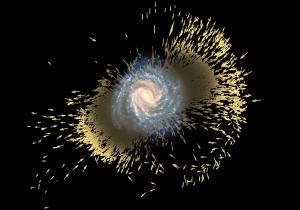Blog
Sausage Breakfast
12 January 2022
 ESA (artist’s impression and composition); Koppelman, Villalobos and Helmi (simulation)
ESA (artist’s impression and composition); Koppelman, Villalobos and Helmi (simulation)A central aspect of galactic evolution is that they must eat or be eaten. Dark energy strives to push galaxies apart, but gravity tries to pull them together. As a result, galaxies tend to form into local groups. As these superclusters of galaxies become more isolated due to cosmic expansion, they gravitationally turn on each other, and in time the largest galaxies of the group will consume the smaller ones. The Milky Way is one of the larger galaxies in our local group, and so it has consumed smaller galaxies in the past. But piecing together the history of these galactic meals is a real challenge.
But thanks to the Gaia spacecraft we’re learning quite a bit, as a recent study shows.1 The results were published in the Astrophysical Journal and reconstructs when the last major galactic merger with the Milky Way occurred.
 NASA, ESA, A. Sarajedini, and G. Piotto
NASA, ESA, A. Sarajedini, and G. PiottoBased on earlier observations, we know that many of the remnant stars from galactic collisions end up in the halo of the Milky Way. This is a roughly spherical collection of stars that surrounds our galaxy. The most recent merger seems to have been with a small galaxy known as Gaia-Sausage-Enceladus (GSE), which happened about 8 - 10 billion years ago. But not many details have been known about this merger. For example, did GSE orbit the Milky Way before colliding, only to be ripped apart by our galaxy’s tidal forces, or was the collision more direct and head-on?
To answer this question, the team used Gaia observations of stars in the halo of the Milky Way and combined that data with a survey of the outer edges of the Milky Way known as the H3 Survey. This gave the team a good understanding of the position and motion of halo stars. They then created numerical simulations of various hypothetical collisions between GSE and the Milky Way. They found that the model which best fits is a galaxy of about half a billion stars that collided with the Milky Way opposite to our galaxy’s rotation. That is, a more direct collision. Based upon this model, about half of our galaxy’s halo stars, and about 20% of the dark matter halo came from this one collision.
The merger with Gaia-Sausage-Enceladus accounts for most of the Milky Way’s mass increase over the past 10 billion years. It was a big breakfast for our galaxy’s cosmic day. Later on, the menu are other meals, including those of the small and large Magellanic clouds, both of which are approaching the Milky Way. Then, of course, there is the grand meal to come, when the Milky Way and Andromeda galaxies collide in about 5 billion years.
Naidu, Rohan P., et al. “Reconstructing the Last Major Merger of the Milky Way with the H3 Survey.” The Astrophysical Journal 923.1 (2021): 92. ↩︎